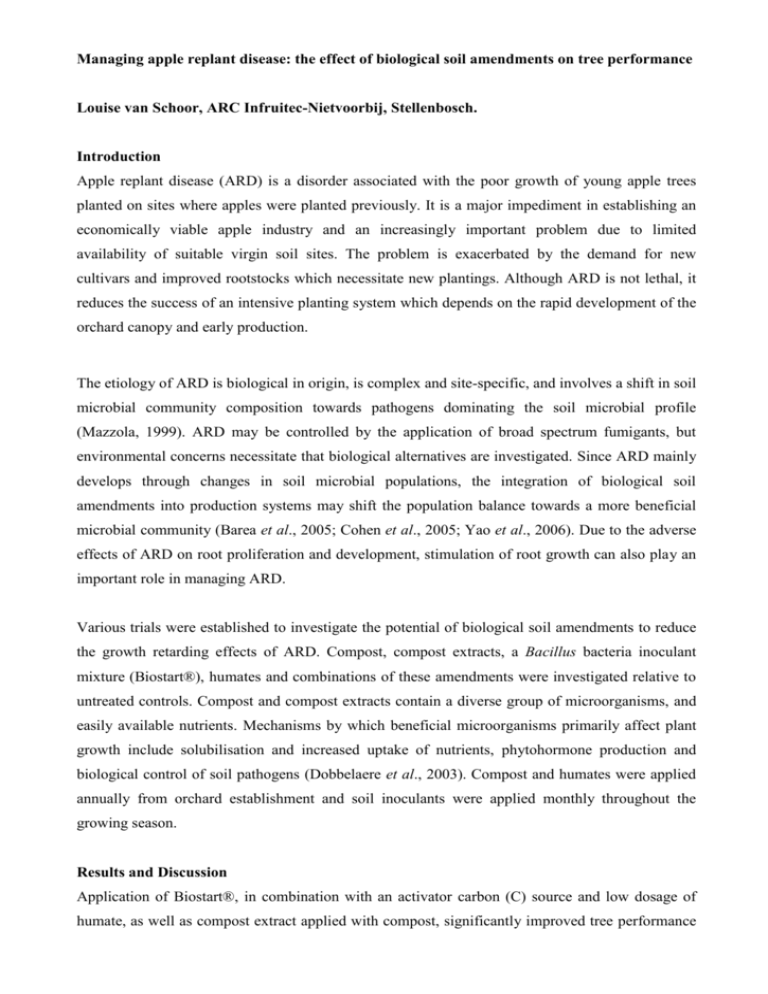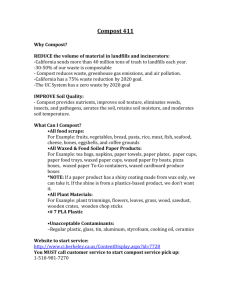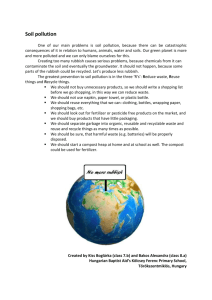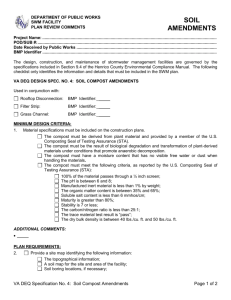Managing apple replant disease: the effect of biological soil
advertisement

Managing apple replant disease: the effect of biological soil amendments on tree performance Louise van Schoor, ARC Infruitec-Nietvoorbij, Stellenbosch. Introduction Apple replant disease (ARD) is a disorder associated with the poor growth of young apple trees planted on sites where apples were planted previously. It is a major impediment in establishing an economically viable apple industry and an increasingly important problem due to limited availability of suitable virgin soil sites. The problem is exacerbated by the demand for new cultivars and improved rootstocks which necessitate new plantings. Although ARD is not lethal, it reduces the success of an intensive planting system which depends on the rapid development of the orchard canopy and early production. The etiology of ARD is biological in origin, is complex and site-specific, and involves a shift in soil microbial community composition towards pathogens dominating the soil microbial profile (Mazzola, 1999). ARD may be controlled by the application of broad spectrum fumigants, but environmental concerns necessitate that biological alternatives are investigated. Since ARD mainly develops through changes in soil microbial populations, the integration of biological soil amendments into production systems may shift the population balance towards a more beneficial microbial community (Barea et al., 2005; Cohen et al., 2005; Yao et al., 2006). Due to the adverse effects of ARD on root proliferation and development, stimulation of root growth can also play an important role in managing ARD. Various trials were established to investigate the potential of biological soil amendments to reduce the growth retarding effects of ARD. Compost, compost extracts, a Bacillus bacteria inoculant mixture (Biostart®), humates and combinations of these amendments were investigated relative to untreated controls. Compost and compost extracts contain a diverse group of microorganisms, and easily available nutrients. Mechanisms by which beneficial microorganisms primarily affect plant growth include solubilisation and increased uptake of nutrients, phytohormone production and biological control of soil pathogens (Dobbelaere et al., 2003). Compost and humates were applied annually from orchard establishment and soil inoculants were applied monthly throughout the growing season. Results and Discussion Application of Biostart®, in combination with an activator carbon (C) source and low dosage of humate, as well as compost extract applied with compost, significantly improved tree performance in ARD sites. Continuous application of these amendments over five seasons to ‘Fuji’ and ‘Ruby Gala’ trees on M793, increased growth by 20-30%, and cumulative yield by 15-40%, compared to untreated plots. No significant differences were found in fruit quality. This orchard showed high infestation of root lesion nematode, even in fumigated plots. It is possible that plants were protected from nematode attack by changes in the soil microbial populations through biological amendment. Positive effects on growth were also observed with compost extract application in ARD orchards in another field study in South Africa (Van Schoor et al., 2009). In pot trials using apple seedlings, the application of compost, as well as sterilised and unsterilised compost extracts, significantly increased growth of apple seedlings in six ARD soils. In three additional ARD field sites (consisting of ‘Fuji’ on M793 and M7 and ‘Royal Gala’ on M793), the effects on tree growth using compost and either Biostart® (with C additions) or compost extract, were only significant in orchards showing mild ARD effects but not those with severe cases of ARD. In the site where ARD symptoms were most severe, biological amendments resulted in little improvement in yield relative to untreated plots. In the other two sites ARD was less severe and biological amendment improved tree growth to the same extent as methyl bromide fumigation over three growing seasons. There was no clear indication of which amendment, in addition to compost, resulted in the best tree performance. Although biological amendments showed promise in reducing ARD symptoms, fumigation gave the most significant and consistent response in tree performance. Effects resulting from fumigation seem to be dramatic and immediate, allowing trees to establish in an environment with little microbial competition, and in the absence of soil pathogens. Due to its broad-spectrum activity methyl bromide is also effective under various soil biological conditions. In contrast to this, effects with biological amendments are more gradual and long term and regular application is essential. Early application is also important, in order for trees to be colonised by beneficial organisms protecting them from pathogen attack. Furthermore, young trees still trying to establish an efficient root system can benefit from improved nutrient solubilisation and microbial plant growth hormone production in the rhizosphere. With continued application, long term changes can be induced in soil microbial communities, making it more difficult for soilborne pathogens to dominate. This can possibly also have positive implications for the next orchard to be established on this site. In this study, application of compost or humates on its own did not result in significant changes in tree performance. Variability in amendments, as well as soil conditions, is one of the biggest impediments in the wide scale use of organic amendments. It has been suggested that controlled inoculation of composts can induce more consistent effects especially in disease suppression (Hoitink et al., 1997). Our results suggest that regular application of a diverse group of microbial inoculants in combination with organic material, may reduce symptoms of ARD. However, effects are site-specific and therefore intensive management and increased knowledge of the plant-soil system is required. Biological approaches to ARD control ultimately should form part of an integrated biological management system to maximise benefits. The use of biological management practices in combination with ARD tolerant rootstocks (Geneva® Rootstock range) may show more consistent effects over a wide range of soil conditions. Acknowledgements The project is funded by the ARC and the DFPT under the Soil Health Programme. For further information contact Louise van Schoor: e-mail, vschoorL@arc.agric.za; Tel., (021) 809 3367. References Barea, J.M., Pozo, M.J., Azcon, R. and Azcón-Aguilar, C., 2005. Microbial co-operation in the rhizosphere. Journal of Experimental Botany 56, 1761-1778. Cohen, M.F., Yamasaki, H. and Mazzola, M., 2005. Brasssica napus seed meal soil amendment modifies microbial community structure, nitric oxide production and incidence of Rhizoctonia root rot. Soil Biology and Biochemistry 37, 1215-1227. Dobbelaere, S., Vanderleyden, J. and Okon, Y., 2003. Plant growth-promoting effects of diazotrophs in the rhizosphere. Critical Reviews in Plant Science 22, 107-149. Hoitink, H.A.J., Stone, A.G. and Han, D.Y., 1997. Suppression of plant diseases by composts. HortScience 32, 184-187. Mazzola, M., 1999. Transformation of soil microbial community structure and Rhizoctoniasuppressive potential in response to apple roots. Phytopathology 89, 920-927. Van Schoor, L., Denman, S. and Cook, N.C., 2009. Characterisation of apple replant disease under South African conditions and potential biological management strategies. Scientia Horticulturae 119, 153-162. Yao, S., Mervin, I.A., Abawi, G.S. and Thies, J.E., 2006. Soil fumigation and compost amendment alter soil microbial community composition but do not improve tree growth or yield in an apple replant site. Soil Biology and Biochemistry 38, 587-599.






